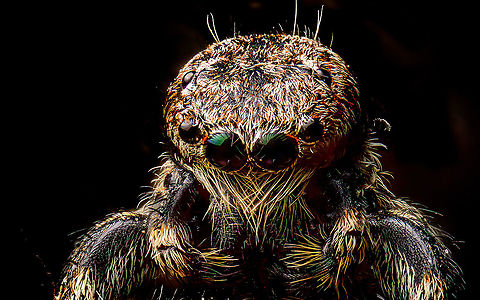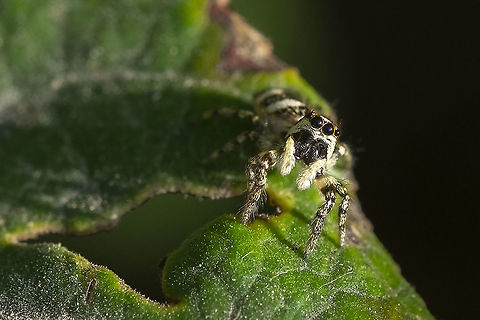
Appearance
Female zebra spiders are 5–9 mm long, while males are 5–6 mm. Male zebra spiders also have distinctly larger chelicerae than females. Spiders in the family Salticidae have especially enlarged anterior median eyes, though the anterior and posterior lateral eyes are also large when compared to the very small posterior median eyes.In total there are eight eyes, with the very large anterior median eyes primarily responsible for its excellent binocular vision. These small spiders are black with white hairs that form stripes.

Naming
Their common name refers to their vivid black-and-white colouration, whilst their scientific name derives from ''Salticus'' from the Latin for “dancing”, in reference to their agility, and the Greek ''scenicus'', translating to “theatrical” or “of a decorative place,” in reference to the flashy, zebra-like coloration of the species.
Distribution
Zebra spiders are widespread across Britain, Europe, and North America, and are found throughout the Holarctic. They often live close to or in human settlements. They can be found on walls, plants and fences on sunny days; and also indoors on window sills, often in the corner behind curtains.
Reproduction
When these spiders meet, the male carries out a courtship dance involving waving his front legs and moving his abdomen up and down. The better the dance the more likely the female will want to mate, with success guaranteed if the male can exhibit a perfect shuffle. Females will stay with their egg sacs and will guard the young after they hatch. After the spiderlings have had their second moult they will leave the mother and fend for themselves.
Food
Zebra spiders tend to hunt smaller spiders and other arthropods. They have been observed feeding on mosquitos that are almost twice their length. They have also been observed taking on prey items up to 3 times the length of the spider, such as some of the smaller species of moth.Like other jumping spiders, these spiders use their large front eyes to locate and stalk their prey. They move slowly towards their prey until they are close enough to pounce on top of their victim, and their hunting behaviour has been described as cat-like.
Using their acute eyesight, they are able to accurately judge the distances they need to jump.They orient towards prey detected by their lateral eyes whenever the angle subtended by such prey exceeds 5.5°. The velocity of the prey is not involved in the determination of reactive distance, but only moving objects elicit orientation. The probability that orientation is followed by stalking is a function of both prey size and velocity. The zebra spider's stalk velocity declines progressively as it nears its prey.
Before jumping, they glue a silk thread to the surface that they are jumping from so that if they miss the target, they can climb up the thread and try again - However, they may 'abseil' with a silk thread if they wish to descend from a height safely, for instance they have been documented 'abseiling' from ceilings. They ignore unappetising insects such as ants.
There are no extensor muscles at the 'hinge joints' of the spider leg, instead joints extension is due to the haemocoelic blood pressure in the leg. The most significant evidence that this extension is due to hydraulic forces is that the leg spines become erect during the jump, a result of increased body pressure which can be demonstrated on many spiders. The zebra spider's jump is almost entirely due to the sudden straightening of the fourth pair of legs. The mean jumping velocity is estimated to be between 0.64–0.79 m/s .
References:
Some text fragments are auto parsed from Wikipedia.